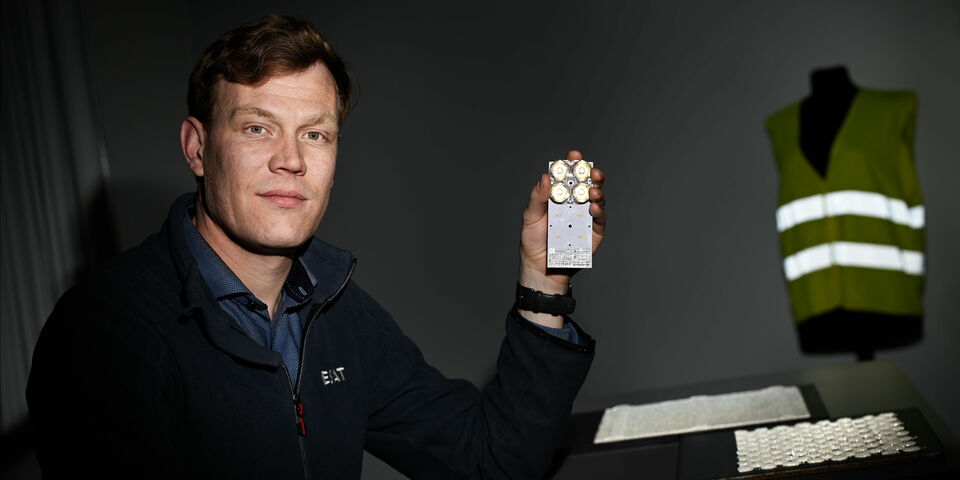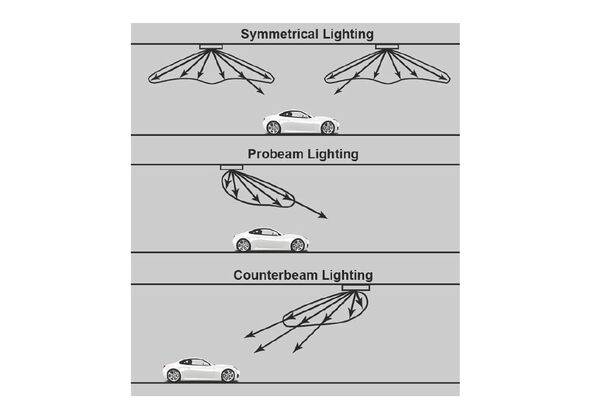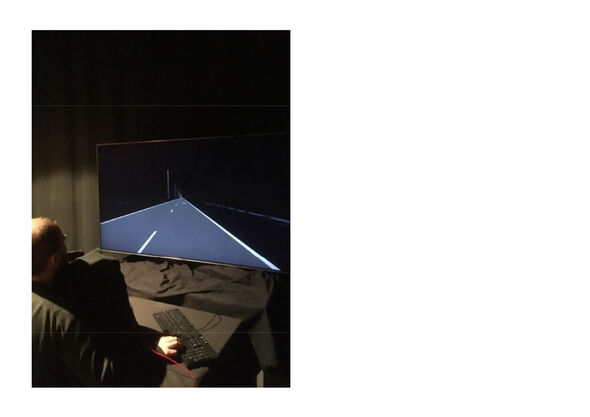Home Stretch | More efficient road lighting
Rijkswaterstaat faces two major challenges in the coming years. On the one hand, they need to halve their energy consumption by 2030 in order to meet the climate targets; on the other hand, they also need to reduce the number of traffic accidents. To help them achieve both goals, PhD candidate Rik Spieringhs developed a new road lighting concept that requires less energy while still ensuring safety.
Spieringhs started his doctoral research at KU Leuven, but soon TU/e became involved, resulting in a joint project between the two universities. “KU Leuven has a special Light & lighting lab in Ghent that is very good at the technical level, such as making all kinds of measurements,” he says. “TU/e, in turn, is very strong when it comes to the interaction between humans and technology, which is also a very important aspect in my research. Ultimately, you need to know how people perceive the illuminated surface.”
While this combination was very beneficial to his research, it did not just bring advantages. “Each university has its own regulations and you have to deal with two different administrative systems. You also have two PhD supervisors, each with their own vision. That also poses a challenge,” he admits. In the end, the PhD candidate, who is originally from Brabant, defended his dissertation twice: after the non-public, so-called preliminary defense in Belgium, he also successfully defended his dissertation last week at TU/e’s Department of Industrial Engineering & Innovation Sciences.
Directing light
The direct motivation for his research was the problem the Dutch Rijkswaterstaat is faced with. Because of the European climate agreement, they are bound by legal obligations regarding climate targets, including energy reduction. For example, by 2030 they must halve their energy consumption for highway lighting. “But it seems that goal is becoming less and less attainable. In some years, there was even an increase in energy consumption,” says Spieringhs. On top of that, Rijkswaterstaat also needs to reduce the number of traffic accidents. At first glance, these two goals seem contradictory, because good road lighting is essential to ensure safety. “To achieve both goals, Rijkswaterstaat must explore technological innovations,” he argues.
In his research, Spieringhs looked at how we can light our roads more efficiently. He asked himself: what innovations can we use to achieve this? For example, he looked at different lighting concepts used to illuminate road markings on highways and pedestrian crosswalks and how they could be improved. “By lighting concepts, we mean how the light is directed,” he explains. “There is a certain amount of light. The question is how to direct it optimally so that you achieve the best visibility.”
Large headlights
He went in search of a lighting concept that could reduce energy consumption while ensuring optimal safety. That is how he found Probeam, an existing concept where you direct the light in the direction of travel, i.e. away from the road users, thereby avoiding glare. “It’s similar to car headlights, but on a large light pole above the road.” One might argue that we already have car headlights, so what would be the added value of this lighting? “Car headlights only illuminate the first 60 meters or so in front of the car,” Spieringhs explains. “With Probeam lighting, you’d be able to illuminate the stretch of road beyond that to increase the illuminated surface. Basically, you want to replicate the effect of driving with a high beam.”
Another innovation he studied is the use of reflective glass beads in road markings, of varying densities and sizes. “These produce high retroreflection, which means you get a large amount of light back.” By combining those two things, you could illuminate roads more efficiently while maintaining the same level of safety.
To determine the best way to do that, he examined the reflective properties of road markings. “Road markings are designed for car headlights, which provide a very flat illumination because the light source is located just above the road. But if you use Probeam, the light shines at a completely different angle,” he explains. “What we wanted to know was: what does this do to the reflective properties of road markings?” By moving a light source forward bit by bit, Spieringhs examined how the reflection changes at different angles and how to best utilize the reflective properties.
Perception
Finally, Spieringhs also looked at perception, as this is important to determine the minimum energy consumption needed to ensure safety. For this, he conducted perception tests with real people. The participants were shown a highway environment with road marker arrows on a screen, and they had to indicate whether they were pointing left or right. “You can keep reducing the brightness of that light until they can barely see it, and then they start guessing,” Spieringhs explains. “That’s exactly the point you want to find. You want people to just be able to see the road markings clearly, and you don’t want to use more energy for that than necessary.”
By combining his observations on reflective properties, perception and lighting optimization, he was able to develop a lighting concept that would reduce the energy consumed by at least 50%. Rijkswaterstaat is currently looking at how they can put this concept into practice. “Before they can do that, they have to conduct further tests and work out all kinds of practical matters, but it certainly has a lot of potential,” says Spieringhs. “I’m very curious to see where it will lead.”
PhD in the picture
What is on the cover of your dissertation?
“In Belgium, you can’t have images on the cover, so it’s very simple, just the title of my thesis, the TU/e and KU Leuven logos and the names of my supervisors.”
You’re at a birthday party. How do you explain your research in one sentence?
“I’m examining how to place headlights on light poles to improve visibility and reduce energy consumption.”
How does your research contribute to society?
“By providing a solution to a problem the government is currently facing, where on the one hand, climate targets must be met and on the other hand, safety has to be ensured.”
How do you blow off steam outside of your research?
“I like to go running. For me, a marathon is a metaphor for the PhD track, because you’re constantly running, but you don’t know how long it will take and if you will make it. Ups and downs are part of it, but if you just keep pushing on, you will eventually reach the finish line.”
What is your next chapter?
“I’m moving on from road lighting to lighting fruits and vegetables. I’m working at a company that manufactures machines for sorting fruits and vegetables based on various quality properties such as juiciness, and that requires special lighting. Same principle, but a completely different application. I can put the knowledge I gained during my PhD trajectory to good use there.”




Discussion